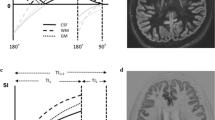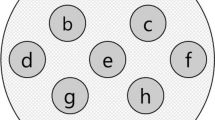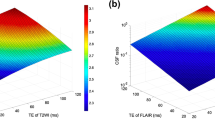Abstract
Objectives
The purpose of this study was to address the feasibility of characterizing the contrast both between and within grey matter and white matter using the phase difference enhanced (PADRE) technique.
Methods
PADRE imaging was performed in 33 healthy volunteers. Vessel enhancement (VE), tissue enhancement (TE), and PADRE images were reconstructed from source images and were evaluated with regard to differentiation of grey-to-white matter interface, the stria of Gennari, and the two layers, internal sagittal stratum (ISS) and external sagittal stratum (ESS), of optic radiation.
Results
White matter regions showed decreased signal intensity compared to grey matter regions. Discrimination was sharper between white matter and cortical grey matter in TE images than in PADRE images, but was poorly displayed in VE images. The stria of Gennari was observed on all three image sets. Low-signal-intensity bands displayed in VE images representing the optic radiation were delineated as two layers of different signal intensities in TE and PADRE images. Statistically significant differences in phase shifts were found between frontal grey and white matter, as well as between ISS and ESS (p < 0.01).
Conclusions
The PADRE technique is capable of identifying grey-to-white matter interface, the stria of Gennari, and ISS and ESS, with improved contrast in PADRE and TE images compared to VE images.
Key Points
• Phase difference enhanced (PADRE) imaging can yield diverse contrasts between tissues
• The PADRE technique utilizes the inherent variety of magnetic susceptibilities
• PADRE MR imaging provides better visualization of certain cerebral anatomy in vivo
• PADRE imaging is able to delineate the stria of Gennari in the primary visual cortex
• PADRE imaging is able to identify the two optic radiation layers







Similar content being viewed by others
Abbreviations
- PADRE:
-
Phase difference enhanced imaging
- VE:
-
Vessel enhancement
- TE:
-
Tissue enhancement
- FGM:
-
Frontal grey matter
- FWM:
-
Frontal white matter
- ISS:
-
Internal sagittal stratum
- ESS:
-
External sagittal stratum
- SWI:
-
Susceptibility-weighted imaging
- GRE:
-
Gradient-recalled echo
References
Rauscher A, Sedlacik J, Barth M, Mentzel HJ, Reichenbach JR (2005) Magnetic susceptibility-weighted MR phase imaging of the human brain. AJNR Am J Neuroradiol 26:736–742
Abduljalil AM, Schmalbrock P, Novak V, Chakeres DW (2003) Enhanced gray and white matter contrast of phase susceptibility-weighted images in ultra-high-field magnetic resonance imaging. J Magn Reson Imaging 18:284–290
Duyn JH, van Gelderen P, Li TQ, de Zwart JA, Koretsky AP, Fukunaga M (2007) High-field MRI of brain cortical substructure based on signal phase. Proc Natl Acad Sci U S A 104:11796–11801
Haacke EM, Xu Y, Cheng YC, Reichenbach JR (2004) Susceptibility weighted imaging (SWI). Magn Reson Med 52:612–618
Hammond KE, Lupo JM, Xu D et al (2008) Development of a robust method for generating 7.0 T multichannel phase images of the brain with application to normal volunteers and patients with neurological diseases. Neuroimage 39:1682–1692
Manova ES, Habib CA, Boikov AS et al (2009) Characterizing the mesencephalon using susceptibility-weighted imaging. AJNR Am J Neuroradiol 30:569–574
Reichenbach JR, Haacke EM (2001) High-resolution BOLD venographic imaging: a window into brain function. NMR Biomed 14:453–467
Yoneda T, Hirai T, Hiai Y, et al (2009) Triple-layer appearance of human cerebral cortices on phase-difference enhanced imaging using 3D principle of echo shifting with a train of observations (PRESTO) sequence. Proc Int Soc Magn Reson Med pp 27
Hagberg GE, Welch EB, Greiser A (2010) The sign convention for phase values on different vendor systems: definition and implications for susceptibility-weighted imaging. Magn Reson Imaging 28:297–300
Yamada N, Imakita S, Sakuma T, Takamiya M (1996) Intracranial calcification on gradient-echo phase image: depiction of diamagnetic susceptibility. Radiology 198:171–178
Robinson RJ, Bhuta S (2011) Susceptibility-weighted imaging of the brain: current utility and potential applications. J Neuroimaging 21:e189–e204
Kakeda S, Korogi Y, Yoneda T et al (2011) A novel tract imaging technique of the brainstem using phase difference enhanced imaging: normal anatomy and initial experience in multiple system atrophy. Eur Radiol 21:2202–2210
Kakeda S, Korogi Y, Yoneda T et al (2013) Parkinson’s disease: diagnostic potential of high-resolution phase difference enhanced MR imaging at 3 T. Eur Radiol 23:1102–1111
Haacke EM, Ayaz M, Khan A et al (2007) Establishing a baseline phase behavior in magnetic resonance imaging to determine normal vs. abnormal iron content in the brain. J Magn Reson Imaging 26:256–264
Series SC (2003) Measurement of observer agreement. Radiology 228:303–308
Shrout PE, Fleiss JL (1979) Intraclass correlations: uses in assessing rater reliability. Psychol Bull 86:420–428
Mori N, Miki Y, Kasahara S et al (2009) Susceptibility-weighted imaging at 3 Tesla delineates the optic radiation. Invest Radiol 44:140–145
Trampel R, Ott DV, Turner R (2011) Do the congenitally blind have a stria of Gennari? First intracortical insights in vivo. Cereb Cortex 21:2075–2081
Clark VP, Courchesne E, Grafe M (1992) In vivo myeloarchitectonic analysis of human striate and extrastriate cortex using magnetic resonance imaging. Cereb Cortex 2:417–424
Fukunaga M, Li TQ, van Gelderen P et al (2010) Layer-specific variation of iron content in cerebral cortex as a source of MRI contrast. Proc Natl Acad Sci U S A 107:3834–3839
Ide S, Kakeda S, Korogi Y et al (2012) Delineation of optic radiation and stria of Gennari on high-resolution phase difference enhanced imaging. Acad Radiol 19:1283–1289
Li TQ, van Gelderen P, Merkle H, Talagala L, Koretsky AP, Duyn J (2006) Extensive heterogeneity in white matter intensity in high-resolution T2*-weighted MRI of the human brain at 7.0 T. Neuroimage 32:1032–1040
Kitajima M, Korogi Y, Takahashi M, Eto K (1996) MR signal intensity of the optic radiation. Am J Neuroradiol 17:1379–1383
Petridou N, Wharton SJ, Lotfipour A, Gowland P, Bowtell R (2010) Investigating the effect of blood susceptibility on phase contrast in the human brain. Neuroimage 50:491–498
Lee J, Hirano Y, Fukunaga M, Silva AC, Duyn JH (2010) On the contribution of deoxy-hemoglobin to MRI gray-white matter phase contrast at high field. Neuroimage 49:193–198
Yao B, Li TQ, Gelderen P, Shmueli K, de Zwart JA, Duyn JH (2009) Susceptibility contrast in high field MRI of human brain as a function of tissue iron content. Neuroimage 44:1259–1266
Lee J, Shmueli K, Kang BT et al (2012) The contribution of myelin to magnetic susceptibility-weighted contrasts in high-field MRI of the brain. Neuroimage 59:3967–3975
Langkammer C, Krebs N, Goessler W et al (2012) Susceptibility induced gray-white matter MRI contrast in the human brain. Neuroimage 59:1413–1419
Cavaglia M, Dombrowski SM, Drazba J, Vasanji A, Bokesch PM, Janigro D (2001) Regional variation in brain capillary density and vascular response to ischemia. Brain Res 910:81–93
Bell MA, Ball MJ (1985) Laminar variation in the microvascular architecture of normal human visual cortex (area 17). Brain Res 335:139–143
Haacke EM, Cheng NY, House MJ et al (2005) Imaging iron stores in the brain using magnetic resonance imaging. Magn Reson Imaging 23:1–25
Curnes JT, Burger PC, Djang WT, Boyko OB (1988) MR imaging of compact white matter pathways. Am J Neuroradiol 9:1061–1068
Brady S, Siegel G, Albers RW, Price D (2005) Basic Neurochemistry: Molecular, cellular and medical aspects. Academic Press
Liu C, Li W, Johnson GA, Wu B (2011) High-field (9.4 T) MRI of brain dysmyelination by quantitative mapping of magnetic susceptibility. Neuroimage 56:930–938
Mackay A, Whittall K, Adler J, Li D, Paty D, Graeb D (1994) In vivo visualization of myelin water in brain by magnetic resonance. Magn Reson Med 31:673–677
Zhong K, Leupold J, von Elverfeldt D, Speck O (2008) The molecular basis for gray and white matter contrast in phase imaging. Neuroimage 40:1561–1566
Shmueli K, Dodd SJ, Li TQ, Duyn JH (2011) The contribution of chemical exchange to MRI frequency shifts in brain tissue. Magn Reson Med 65:35–43
Saini J, Kesavadas C, Thomas B et al (2009) Susceptibility weighted imaging in the diagnostic evaluation of patients with intractable epilepsy. Epilepsia 50:1462–1473
Madan N, Grant PE (2009) New directions in clinical imaging of cortical dysplasias. Epilepsia 50(Suppl 9):9–18
van Rooden S, Versluis MJ, Liem MK et al (2014) Cortical phase changes in Alzheimer's disease at 7 T MRI: A novel imaging marker. Alzheimers Dement 10:e19–e26
Bridge H, Clare S (2006) High-resolution MRI: in vivo histology? Philos Trans R Soc B Biol Sci 361:137–146
Acknowledgments
The scientific guarantor of this publication is Guangbin Wang. The authors of this manuscript declare no relationships with any companies whose products or services may be related to the subject matter of the article. This work was supported by the National Natural Science Foundation of China under Grant No.81171380. No complex statistical methods were necessary for this paper. Institutional review board approval was obtained. Written informed consent was obtained from all subjects (patients) in this study. This article has not been published elsewhere in whole or in part. Methodology: prospective, experimental; performed at one institution.
Author information
Authors and Affiliations
Corresponding author
Rights and permissions
About this article
Cite this article
Yang, L., Wang, S., Yao, B. et al. Characterizing the contrast of white matter and grey matter in high-resolution phase difference enhanced imaging of human brain at 3.0 T. Eur Radiol 25, 1068–1076 (2015). https://doi.org/10.1007/s00330-014-3480-7
Received:
Revised:
Accepted:
Published:
Issue Date:
DOI: https://doi.org/10.1007/s00330-014-3480-7




